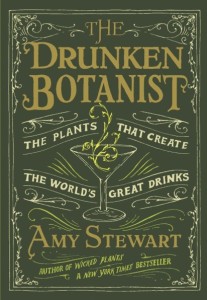 No, it’s not a murder mystery or a light romantic comedy. The Drunken Botanist is a botanical exploration of “The plants that create the world’s great drinks,” as its subtitle says. Now, I’m not particularly interested in plants, per se. I live with someone who loves plants and has an inordinately green thumb. But I just don’t much notice plants, even when they’re right in front of my face. A bouquet on the dinner table is usually wilted before I realize it’s there. But when I heard Amy Stewart talking about her book on the radio and realized that all alcohol – which is one of my favorite subjects – is made from plants, I knew I had to read and review it.
No, it’s not a murder mystery or a light romantic comedy. The Drunken Botanist is a botanical exploration of “The plants that create the world’s great drinks,” as its subtitle says. Now, I’m not particularly interested in plants, per se. I live with someone who loves plants and has an inordinately green thumb. But I just don’t much notice plants, even when they’re right in front of my face. A bouquet on the dinner table is usually wilted before I realize it’s there. But when I heard Amy Stewart talking about her book on the radio and realized that all alcohol – which is one of my favorite subjects – is made from plants, I knew I had to read and review it.
Stewart is smart, sharp and witty. But of course she is, she owns a bookstore in Northern California. She has written several other entertaining books about the natural world, including one about earthworms, one about poisonous and otherwise dangerous plants, and another about “diabolical insects.”
The Drunken Botanist is, first, a lovely book. It has a sturdy green cover and green endplates, and has a lot of design touches that make it somewhat resemble a Victorian compendium. Kudos to Tracy Sunrize Johnson for her clever design.
The contents are divided into three parts. The first is about how the three main kinds of beverage alcohol – wine, beer and spirits – are made through the processes of fermentation and distillation. This comes in an alphabetical list of the more common things from which alcohol is made, from agave to wheat, followed by a sampling of more obscure sources of alcohol from around the world. Like the monkey puzzle tree, parsnips, and tamarind. The second part covers the various plant products with which alcohol and beverages are flavored, including herbs and spices, flowers, trees, fruit, and nuts and seeds. These are as common as cinnamon or hops and as exotic as elderflower and tonka bean. The third is a trip into the garden and orchard to explore the ingredients from which mixers and garnishes are made, from grapefruit peel to mint or cilantro leaves.
Sprinkled throughout are recipes for cocktails both common (martinis, margaritas) and exotic (bison grass cocktail, lavender-elderflower champagne cocktail). And recipes for making your own syrups, infusions and garnishes. Even hits for the best varieties of vegetables, herbs, flowers and fruits to grow if you want to create your own drinks. Really quite the complete bartender’s companion, with a few more scientific touches than you’ll find in your average drink guide. Such as the botanical name of every plant mentioned, and a lot of background on where it came from and how it’s been used down the years.
I especially appreciate the way she tries, as a good journalist, to put to rest a number of myths. As she says in the introduction:
The history of drinking is riddled with legends, distortions, half-truths, and outright lies. I didn’t think any field of study could be more prone to myths and misstatements than botany, but that was before I started researching cocktails. Facts tend to get bent out of shape over a round of drinks, and liquor companies aren’t obliged to stick to the truth at all: their secret formulas can remain a secret, and the burlap bags of herbs placed about the distillery might be there only for ambience or even for misdirection.”
And she starts the myth-busting right in the first section, the one on agave. Of course, few spirits are so surrounded by myth and misunderstanding as tequila and its relatives, starting with who brought it to the attention of Europeans.
If you read any number of popular books on tequila (or browse the boozier corners of the Internet), you may learn that *A. tequilana* was named by a German botanist called Franz Weber, who visited Mexico in the 1800s. However, botanical literature says otherwise …
It’s not often that you’ll encounter a writer who is thorough as well as entertaining, but Stewart is both. In The Drunken Botanist she skillfully weaves together science, history and sociology to humorously but accurately tell the story of alcohol, which has been a part of civilization since civilization began. Now, if you’ll excuse me, I’m going to retire to the armchair with my dram of Nicaraguan rum and re-read the fascinating chapter on the history of sugarcane.
(Algonquin Books of Chapel Hill, 2013)
